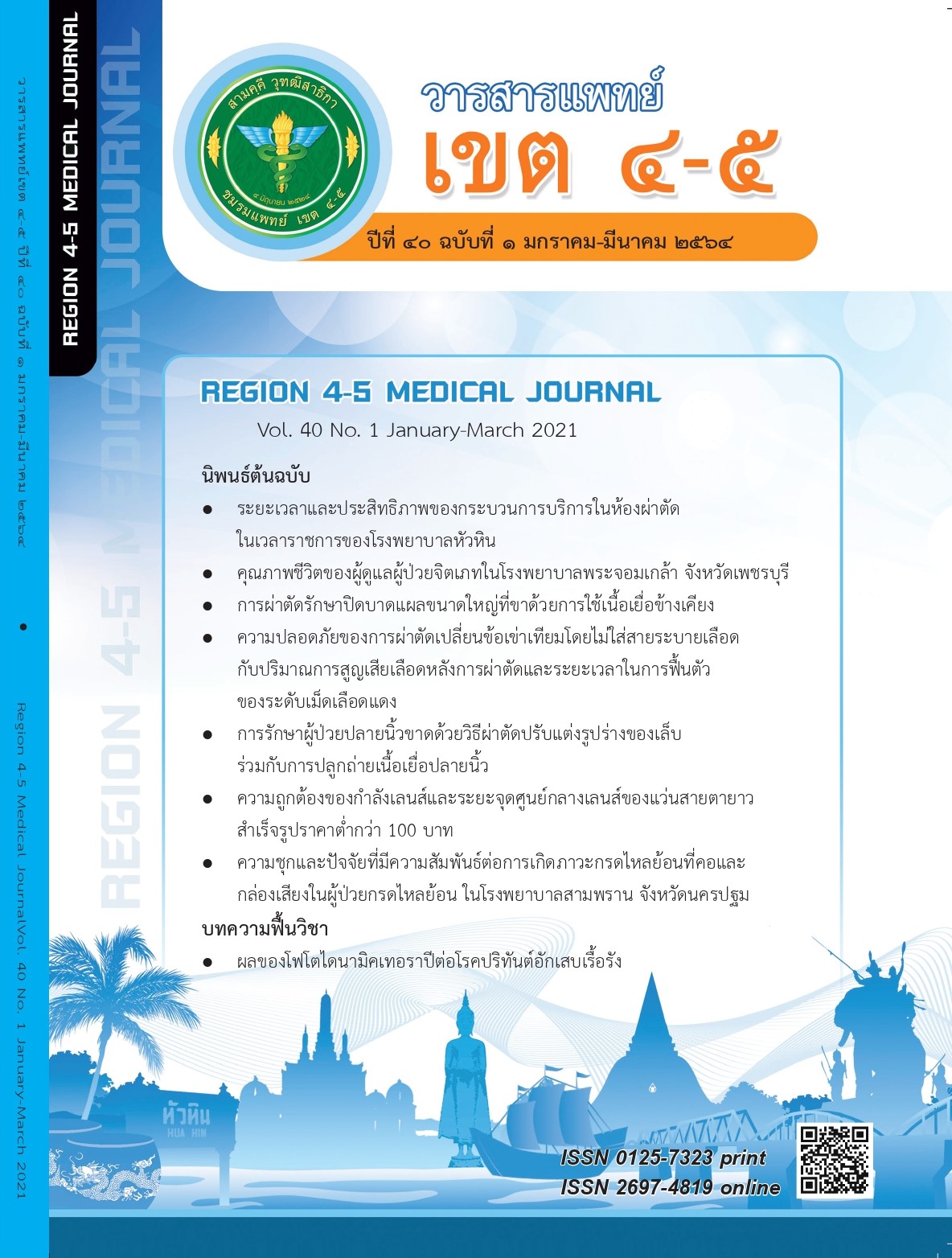Use of Space Blanket for Reducing the Incidence of Postanesthetic Shivering
Keywords:
space blanket, incidence, postanesthetic shiveringAbstract
Objective: Postanesthetic shivering is a common complication of anesthesia. Shivering is usually triggered by hypothermia. Shivering is believed to increase oxygen consumption, increase the postoperative complication. The combination of force-air warming devices, warmed intravenous fluid and medications are provided. However, the gold standard for the treatment and prevention has not been defined yet, and the overall quality of anti-shivering guideline is low. Some study found the space blanket used pre-emptively can reduce the incidence of postanesthetics shivering, but not common use in Thailand. Our study interested to examine the effectiveness of space blanket use for reduces the incidence of post-anesthetic shivering.
Methods: This study was a randomized controlled trial, collected data from the medical and anesthetic records from 1st September 2020 to 31st October 2020. A total of 342 patients undergoing surgery under general or spinal anesthesia was allocated and randomized by computer equally, n = 171 in each groups, into the space blanket group and control group. Both groups were treated as standard e.g. force air warming devices, warmed intravenous fluid and medication. The data were collected in demographic data surgical data and anesthetic data, analyzed using frequency, percentage, mean, standard deviation, independent t test, and chi-square with 95% confidence interval, reflected a significant level at .05.
Results: The overall incidence of postoperative shivering was 15 patients (4.4%). There were significantly less shivering in the space blanket group compared to the control group (3, 1.75% vs. 12, 7.01%), p=.017. The body temperatures were compared between two groups, 36.94 + 0.26 in the space blanket groups and 36.87 + 0.47 in control groups, higher body temperatures in the space blanket group was observed, significantly different (p=.008). There were no significantly differences in age, gender, ASA physical status, duration, blood loss between 2 groups.
Conclusion: We concluded that the use of space blanket helps decreases the incidence of postanesthetic shivering and results in higher body temperature.
References
2. Buggy D, Hughes N. Pre-emptive use of space blanket reduced shivering after general anesthesia. Br J Anaesth. 1994; 72(4): 393-6. Doi: 10.1093/bja/72.4.393.
3. Young VL, Watson ME. Prevention of Perioperative Hypothermia in Plastic Surgery. Aesthet Surg J. 2006; 26(5): 551-71. Doi: 10.1016/j.asj.2006.08.009.
4. Deacock S, Holdcroft A. Heat retention using passive systems during anaesthesia: comparison of two plastic wraps, one with reflective properties. BJA. 1997; 79(6): 766-9.
5. Fadzlina MS, Nazaruddin HM, Hardy ZR. Passive Warming using a Heat-Band versus a Resistive Heating Blanket for the Prevention of Inadvertent Perioperative Hypothermia during Laparotomy for Gynaecological Surgery. Malays J Med Sci. 2016; 23(2): 28–37.
6. Eberhart LH, Doderlein F, Eisenhardt G, et al. Independent risk factors for postoperative shivering. Anesth Analg. 2005; 101(6): 1849-57. doi: 10.1213/01.ANE.0000184128.41795.FE.
7. Buggy DJ, Crossley AW. Thermoregulation, mild perioperative hypothermia and postanaesthetic shivering. Br J Anaesth. 2000; 84(5): 615-28. doi: 10.1093/bja/84.5.615.
8. Plattner O, Ikeda T, Sessler DI, et al. Postanesthetic Vasoconstriction Slows Peripheral-to-Core Transfer of Cutaneous Heat, Thereby Isolating the Core Thermal Compartment. Anesth Analg. 1997; 85(4): 899-906. doi: 10.1097/00000539-199710000-00034.
9. Deepom J, Lounpirun S, Hamtaisong K. Associated factors of Hypothermia during General Anesthesia. Nursing Health and Education Journal. 2019; 2(3): 1-11.
10. Pualek K. Factors Affecting to Hypothermia and Shivering for Developing Warm-up Programs in Surgery Patients Undergone Spinal Block. Udonthani Hospital Medical Journal. 2017; 25(3): 294-305.
11. Hindsholm KB, Bredahl C, Herlevsen P. Reflective blanket used for reduction of heat loss during regional anaesthesia. Br J Anaesth. 1992; 68(5): 531-3. doi: 10.1093/bja/68.5.531.
12. Avellanasa ML, Ricartb A, Botellac J, et al. Management of severe accidental hypothermia. Med Intensiva. 2012; 36(3): 200-12.
13. Kurz A, Sessler DI, Lenhardt R. Perioperative normothermia to reduce the incidence of surgical-wound infection and shorten hospitalization. Study of Wound Infection and Temperature Group. N Engl J Med. 1996; 334(109): 1209-15. doi: 10.1056/NEJM199605093341901.
14. Roundtable summary: perioperative temperature management. Anesthesiology News [internet]. 2005 October [cited 2017 January]. Available from: URL: http://www. anesthesiologynews.com.
15. Dhar P. Managing perioperative hypothermia. J Anesth. 2000; 14(2): 91-7. doi: 10.1007/s005400050073.
16. Frank SM, Fleisher LA, Breslow MJ, et al. Perioperative maintenance of normothermia reduces the incidence of morbid cardiac events. A randomized clinical trial. JAMA. 1997; 277(14): 1127-34.
17. Leslie K, Sessler DI, Bjorksten AR, et al. Mild hypothermia alters propofol pharmacokinetics and increases the duration of action of atracurium. Anesth Analg. 1995; 80(5): 1007-14. doi: 10.1097/00000539-199505000-00027.
18. Bissonnette B, Sessler DI. Mild hypothermia does not impair postanesthetic recovery in infants and children. Anesth Analg. 1993; 76(1): 168-72. doi: 10.1213/00000539-199301000-00028.
19. Staab DB, Sorensen VJ, Fath JJ, et al. Coagulation defects resulting from ambient temperature-induced hypothermia. J Trauma. 1994; 36(5): 634-8. doi: 10.1097/00005373-199405000-00006.
20. Schmied H, Kurz A, Sessler DI, et al. Mild hypothermia increases blood loss and transfusion requirements during total hip arthroplasty. Lancet. 1996; 347(8997): 289-92. doi: 10.1016/s0140-6736(96)90466-3.
Downloads
Published
How to Cite
Issue
Section
License
ลิขสิทธิ์บทความเป็นของผู้เขียนบทความ แต่หากผลงานของท่านได้รับการพิจารณาตีพิมพ์ลงวารสารแพทย์เขต 4-5 จะคงไว้ซึ่งสิทธิ์ในการตีพิมพ์ครั้งแรกด้วยเหตุที่บทความจะปรากฎในวารสารที่เข้าถึงได้ จึงอนุญาตให้นำบทความในวารสารไปใช้ประโยชน์ได้ในเชิงวิชาการโดยจำเป็นต้องมีการอ้างอิงถึงชื่อวารสารอย่างถูกต้อง แต่ไม่อนุญาตให้นำไปใช้ในเชิงพาณิชย์




